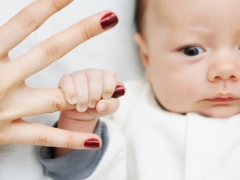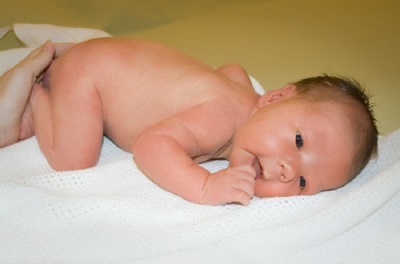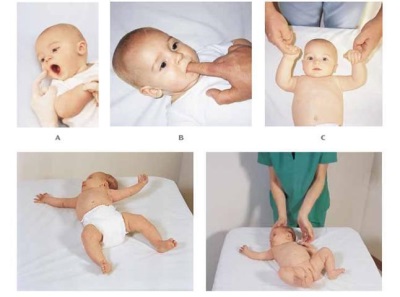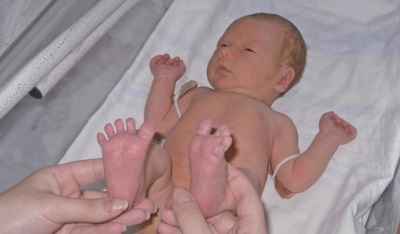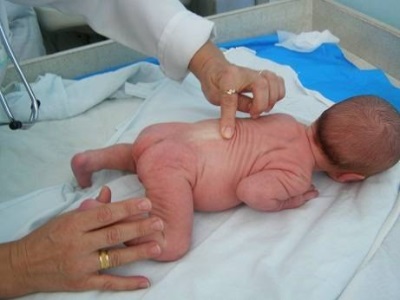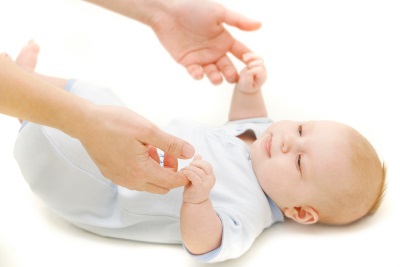Reflexes of the newborn
In order for the newborn baby to survive after giving birth and quickly adapt to the new conditions of life, nature gave the baby reflexes. So called reactions to any stimuli, both acting on the child from the outside, and internal. At the same time, the newly born baby has many reflexes that he needs only in the first months of life. Testing and evaluating them helps determine if the baby is healthy.
Basic reflexes and their types
Congenital reflexes, which are also called unconditional, are extremely important for the survival of a newborn. Thanks to them, the child can take the first breath, find her mother's breast, suck milk, or grab onto her mother if she feels the fall. These are physiological reflexes that must be present in all healthy babies. Many of them fade away and completely disappear by 3-4 months of age.
If they remain at an age when they should have been absent long ago, these will be pathological reflexes. However, there are many unconditioned reflexes that do not disappear. For example, important physiological reflexes that remain in a child even after the neonatal period are represented by vomiting, corneal, swallowing, and other reflexes.
Further, as the little one grows, new reflexes appear in his life, based on the experience of the little ones. They are called conditional, since certain conditions are needed for their development, for example, if a mother breastfeeds a toddler in a certain position, then when she puts the baby into this position, the baby will immediately begin to make sucking movements. The conditional reflexes that are important for the crumbs of the first year of life include grabbing objects with hands, chewing, and independent walking.
All innate reflexes pediatricians are divided into groups depending on their focus. They release reflexes that:
- Provide livelihoods. The baby will not be able to live without sucking, swallowing and respiratory reflexes, as well as without spinal reflexes (so called reactions associated with the state of the muscular system of the child).
- Protect the baby from external irritants. Such irritants can be heat, cold, bright light and other factors.
- Need a baby temporarily. An example of such reflexes can be called a breath hold, when the baby moves through the birth canal, as well as the push out reflex, due to which the baby is protected from ingestion of solid food up to a certain age (so that the child does not choke).
Unconditioned reflexes of the newborn, which are caused by exposure to or near the mouth, are called oral. This group of reflexes includes sucking, proboscis, swallowing, search (it is also called the Kussmaul reflex), the Babkin reflex, and others. The reflexes for which the spinal cord is responsible are called spinal. These include reflexes Moro, Galant, Bauer, support, grasping, protective and other reflexes.
Table of the main congenital reflexes
The name of the reflex, the age of manifestation | How to cause and what the reaction is normal |
Sucking (from the first hours after birth to 3-4 months) | Hold the child's cheek, insert the index finger in the crumbs mouth or give the baby a breast or bottle - the child will begin to make sucking movements. |
Protective (from the first hours after birth to 1.5 months) | Lay the baby on the belly - the baby reflexively turns his head to the side. |
Prehensile (from birth to 3-6 months) | Press the baby on your palms with something - the baby will clasp the object or your fingers with her palms. |
Props (from birth to 1-2 months) | Put the baby upright so that the baby touches the feet of a solid support - the baby will straighten the torso and will stand on a complete foot. |
Stepper (from birth to 1-2 months) | To put the baby upright and tilt the baby slightly forward - the baby, when tilted, will make several automatic stepping movements. |
Search (from birth to 3-4 months) | Stroking a baby's cheek or corner of the baby's mouth - the child will turn his head towards irritation, lower his lip and move his tongue. If you press on the upper lip of the baby, the crumb will unbend the head and open the mouth, and when you press the lower lip, cause the head to flex and lower the lower jaw. |
Breath holding (from birth to 4-5 months) | Dip the baby into the water, splash water on the face of the toddler or send a stream of air to the baby's face - the baby will hold his breath for a few seconds and close his eyes. |
Galant (from 5-6 days of life to 3-4 months) | To run a hand along the back of the child along the spine - the baby will kick the back and the leg on the side of the call of the reflex will unbend in the joints. |
Proboscis (from birth to 2-3 months) | Quickly touch your finger to the lips of the baby - a crumb will stretch the lips forward. |
Babinsky (from birth to 1-2 years) | Hold a stroke on the sole of the child - the foot will bend from the back side, and the fingers will fan out like a fan. |
Robinson (from birth to 3-6 months) | Give the baby a thumbs up and lift the baby - the baby will clasp the fingers tightly with his palms and hold on. |
Perez (from birth to 3-4 months) | Swipe your fingers along the baby’s spine (along its spinous processes), moving upwards from the coccyx bone to the cervical region - the baby will start screaming (the reflex call is perceived negatively), lifts the head, straightens and bends the legs and arms. |
Babkina (from birth to 2-3 months) | Press your thumbs on both palms crumbs - the baby will open his mouth and bend his head. |
Moro (from the first day after birth to 4 months) | Put the baby on the back and hit on both sides of his head on the surface, lift the baby’s legs together with the pelvis, sharply lower the baby in his arms 20-30 cm down, and then lift it back - the baby will pull the handles to the sides and open the cams, after What will return the hands back as if hugging someone. |
Bauer (from 3-4 days of life to 4 months) | Lay the child on his stomach, and then apply a palm to his feet - the crumb begins to crawl spontaneously, pushing off his hands with his feet, but without coordinating his movements (this causes the second name of this reflex - “spontaneous crawling”). |
How to check many important reflexes, you can see by watching the following video.
Causes of an abnormal reaction to the call reflex
Reflexes may be weak or absent when:
- Hypoxic CNS damage during labor.
- Cerebral palsy.
- Intracranial birth injury.
- Muscle hypotonia.
- Spinal cord injuries.
- Oppression of the nervous system medication.
- Paresis.
How to develop reflexes?
For the successful development of conditioned reflexes in a young child, it is important to act systematically and regularly. For example, to stimulate the grasping reflex, the baby needs to constantly put different things in the handles, hang toys above the crib, which the crumbs want to touch, offer to grab things that they like.
With regular exercise, parents can develop the reflexes of crawling, walking, chewing, and many others, which the crumb learns in the first year of life.
What if reflexes are reduced or absent?
In some infants, reflexes do not appear immediately or their inclusion is delayed, which is often associated with birth injuries or diseases of the central nervous system. Immediately after birth, the pediatrician should check the basic reflexes and assist the baby in their absence.
Especially important is the sucking reflex, because with it the baby gets food. If it is absent, the baby has to be fed through a bottle or a probe, and in some cases it is necessary to inject nutrients intravenously.
After discharge of all the children from the maternity hospital, the pediatrician inspects every month and in a situation when a reflex is poorly expressed or persists after the period in which it must fade, the doctor will send the baby for a more detailed examination to a neurologist. The specialist will evaluate all reflexes and, if necessary, prescribe the treatment required by the baby.
In the next video, the popular doctor Komarovsky will tell even more about the unconditioned reflexes of a newborn baby.
